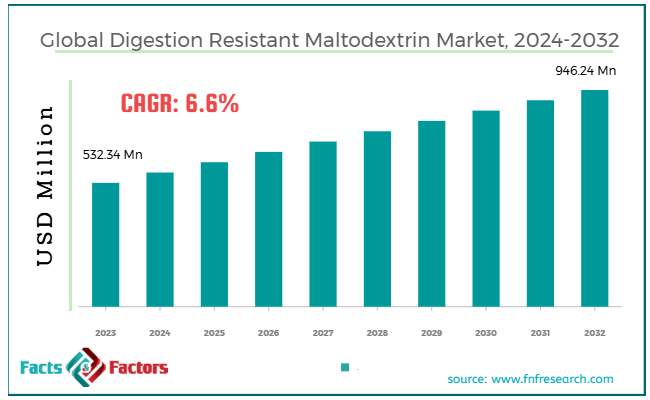Search Market Research Report
Digestion Resistant Maltodextrin Market Size, Share Global Analysis Report, 2024 – 2032

Digestion Resistant Maltodextrin Market Size, Share, Growth Analysis Report By Source (Corn-based, Wheat-based, Potato-based, and Others), By Form (Powder, Liquid, Granular), By End Use Application (Food & Beverages, Pharmaceuticals, Dietary Supplements, Animal Feeds, and Others), And By Region - Global Industry Insights, Overview, Comprehensive Analysis, Trends, Statistical Research, Market Intelligence, Historical Data and Forecast 2024 – 2032
Industry Insights
[221+ Pages Report] According to Facts & Factors, the global digestion resistant maltodextrin market size was worth around USD 532.34 million in 2023 and is predicted to grow to around USD 946.24 million by 2032, with a compound annual growth rate (CAGR) of roughly 6.6% between 2024 and 2032.

 Market Overview
Market Overview
Digestion-resistant maltodextrin, or DRM, is a carbohydrate that fights digestion in the body’s small intestine. DRM effectively passes via the digestive system, usually intact, and touches the large intestine, where it performs as a prebiotic, aiding gut health. The global digestion resistant maltodextrin market is projected to grow substantially due to its increasing application in diverse industries like nutraceuticals, food and beverages, and pharmaceuticals.
Furthermore, the growing health consciousness among the majority population and increasing chronic disorders are majorly impelling the market growth. People are becoming health-conscious and prefer high-fiber, low-glycemic, and gut-friendly food items. DRM provides benefits like blood sugar control and enhanced digestion that support the present dietary trends.
Also, the rising cases of chronic diseases, such as obesity, digestive disorders, and diabetes, among others, are fueling the demand for fiber-rich and low-glycemic foods. Digestive-resistant maltodextrin also helps to promote gut health and manage blood sugar levels. This increases its appeal as a vital ingredient in supplements and functional foods.
However, low consumer awareness in some regions and impending digestion discomfort may hinder the growth of the market. With the rising health awareness among a large population, DRM is not yet recognized widely, mainly in rural regions and unexplored areas, where people may be unfamiliar with its advantages. This low awareness may significantly hamper its adoption, thus impacting global growth.
Moreover, while digestive resistant maltodextrin is important for gut health, its excessive intake may lead to gastrointestinal discomforts like gas and bloating. This could restrain the growth of the global market. Yet, the market is projected to witness remarkable growth owing to the increasing popularity of clean-label products and improvements in the development of food products.
As more consumers demand transparency in food ingredients, DRM rightly complies with the clean-labeled trend. Its minimal processing, natural source, and health advantages make it ideal to satisfy consumers looking for options like natural food and free-form options. Also, improvements in product formats like adding DRM in dairy and baked foods, offer key opportunities.
 Key Insights:
Key Insights:
- As per the analysis shared by our research analyst, the global digestion resistant maltodextrin market is estimated to grow annually at a CAGR of around 6.6% over the forecast period (2024-2032)
- In terms of revenue, the global digestion resistant maltodextrin market size was valued at around USD 532.34 million in 2023 and is projected to reach USD 946.24 million by 2032.
- The digestion resistant maltodextrin market is projected to grow significantly owing to the growing popularity of functional beverages, increasing incidences of digestive disorders, and rising applications in the pharmaceutical industry.
- Based on source, the corn-based segment is expected to lead the market, while the wheat-based segment is expected to register considerable growth.
- Based on form, the powder segment is the dominating segment among others, while the liquid segment is projected to witness sizeable revenue over the forecast period.
- Based on end-use application, the food & beverages segment is expected to lead the market as compared to the dietary supplements segment.
- Based on region, North America is projected to dominate the global market during the estimated period, followed by Asia Pacific.
 Growth Drivers
Growth Drivers
- Growing preference for natural ingredients and clean labels drive the digestion resistant maltodextrin market growth
As individuals are becoming aware of artificial ingredients and food additives, there is a rising preference for foods with clean labels. Digestive resistant maltodextrin, obtained naturally from wheat or corn, supports this demand and offers transparency in food products' ingredients. This remarkably impacts the growth of the digestion resistant maltodextrin industry.
As per reports, nearly 40% of individuals prefer clean-label food products, and 70% of worldwide users are willing to spend money on foods that offer natural and simple ingredients. The clean-label demand is majorly driving the need for DRM. Manufacturers are also increasingly using DRM in their food production to satisfy the rising demand for simple and healthy foods.
- The rising prominence of prebiotics in dietary supplements notably fuels the market growth
Prebiotic fibers, such as DRM, are gaining prominence and significance in dietary supplements as individuals look for foods that enhance digestive health and gut flora. This trend complies with the rising interest in wellness and personalized health, where consumers seek supplements that aid digestion, immunity, and metabolic functions. The prebiotics industry was estimated at $ 5.2 billion in 2021 and is projected to progress at a 9.8% CAGR by 2030.
Furthermore, reports indicate that DRM is gaining prominence in a broader range of dietary supplements that aim for immune function, gut health, and weight management. Companies like Ingredion and Beneo are widening their product lines with DRM-enabled solutions modified for supplements.
 Restraints
Restraints
- Significant production costs adversely impact the progress of the digestion resistant maltodextrin market
The production process for digestive-resistant maltodextrin comprises expert techniques to ensure its digestion resistance. This process needs more developed and expensive technology than the one applied for customary maltodextrin. The demand for superior-quality raw materials and certain processes contributed to elevated production costs.
Currently, many manufacturers are discovering ways to decrease costs by scaling up their production processes and enhancing production efficacy. However, higher price gaps in comparison to conventional ingredients like the customary maltodextrin still prevail in the market, hindering the market growth.
 Opportunities
Opportunities
- Technological improvements in food processing to propel the digestion resistant maltodextrin market growth
Improvements in food processing techniques are one of the leading opportunities in the global digestion resistant maltodextrin market. It allows the integration of DRM in a broader range of food products without compromising texture or flavor. This offers opportunities for its numerous applications in diverse consumer goods.
Modernizations in food technology have significantly contributed to $ 781 million valuations of the digestive-resistant maltodextrin industry by 2034, thus highlighting the significance of technology in production scaling.
Businesses are also heavily spending on R&D to enhance the functionality of digestive-resistant maltodextrin in processed foods to widen its applications in diverse food categories.
 Challenges
Challenges
- Possible digestive discomfort for individuals limits the growth of the digestion resistant maltodextrin market
As a fiber, digestive-resistant maltodextrin may cause discomforts like diarrhea, gas, and bloating when ingested in higher quantities. This may discourage individuals, mainly those with sensitive digestive systems, from adding DRM products to their regular diets.
As per studies, nearly 10-15% of consumers may face digestive uneasiness after ingesting high quantities of fiber, comprising DRM. This side-effect may restrict its use, mainly for foods promoted as digestive aids.
Studies have also shown that while digestive resistant maltodextrin is usually better tolerated, surplus intake may result in gastrointestinal ill effects, which may refrain users from using DRM food products.
 Report Scope
Report Scope
Report Attribute |
Details |
Market Size in 2023 |
USD 532.34 Million |
Projected Market Size in 2032 |
USD 946.24 Million |
CAGR Growth Rate |
6.6% CAGR |
Base Year |
2023 |
Forecast Years |
2024-2032 |
Key Market Players |
Roquette Frères S.A., Ingredion Incorporated, Tate & Lyle, Grain Processing Corporation, WGC Co. Ltd., Kraft Heinz Company, Cargill Incorporated, Archer Daniels Midland Company, Baolingbao Biology Co. Ltd., Tereos Syral S.A.S., Changchun Dacheng Industrial Group, Henan Feitian Agricultural Development Co. Ltd., Gulshan Polyols Ltd., Luzhou, Matsutani Chemical Industry Co. Ltd., and Others. |
Key Segment |
By Source, By Form, By End Use Application, and By Region |
Major Regions Covered |
North America, Europe, Asia Pacific, Latin America, and the Middle East &, Africa |
Purchase Options |
Request customized purchase options to meet your research needs. Explore purchase options |
 Segmentation Analysis
Segmentation Analysis
The global digestion resistant maltodextrin market is segmented based on source, form, end use application, and region.
Based on source, the global digestion resistant maltodextrin industry is divided into corn-based, wheat-based, potato-based, and others. The corn-based segment held a substantial share of the market owing to the cost and availability, rising demand in the food and beverage industry, and its health benefits.
On a global scale, corn is the most widely grown crop, mainly in North America, where corn food products are easily accessible and broadly available. Corn DRM is a highly preferred option for application in beverages, functional foods, and dietary supplements. Its solubility and neutral flavor make it highly suitable for a broader range of food products.
Furthermore, corn digestive resistant maltodextrin is mainly preferred for its rich fiber content and ability to aid digestive health. Health-conscious individuals actively demand digestive health.
Based on form, the global digestion resistant maltodextrin industry is segmented as powder, liquid, and granular. The powder segment is projected to lead the market owing to its ease of use in broader applications and versatility. In addition, its wide application, ease of handling, and solubility are the key factors for segmental growth. Powdered DRM can be easily used in diverse products like beverages, functional foods, dairy products, dietary supplements, and snacks. Also, it is simple to use, transport, and package in powdered form.
Furthermore, powdered digestive resistant maltodextrin holds a better shelf life, which is a key benefit in the supplement and food industries. Despite being in powdered form, DRM well dissolves in several liquids, increasing its suitability for many drink and food applications. This improves its versatility, thus impacting the market growth.
Based on end-use application, the global digestion resistant maltodextrin market is segmented as food & beverages, pharmaceuticals, dietary supplements, animal feeds, and others. The food & beverages segment is anticipated to lead the market over the estimated period owing to its growing use in numerous food items like beverages, snacks, and functional foods. The segment accounts for approximately 67% of the global market in 2024.
In beverages, DRM is widely used in energy drinks, smoothies, and most other beverages aimed at digestive health. In snacks, DRM improves fiber content without compromising the texture of taste. In functional foods, DRM is specially designed to offer advantages beyond mere nutrition, like weight management and digestive health.
 Regional Analysis
Regional Analysis
- North America to witness significant growth over the forecast period
North America held a larger share of the global digestion resistant maltodextrin market and is projected to continue dominance over the estimated period as well. The key reasons for the regional growth comprise growing wellness and health trends, technological improvements, and growing demand for functional ingredients.
Most consumers in the U.S. prioritize their health, resulting in elevated demand for prebiotic fiber and low-calorie ingredients like digestive resistant maltodextrin. This trend is anticipated to fuel industry growth in North America.
Moreover, modernizations in making digestive resistant maltodextrin have improved its functionality, thus increasing its appeal to consumers and producers alike. These improvements have majorly contributed to the industry's growth in developed markets like the U.S. The regional growth is also propelled by the region's growing demand for functional ingredients in foods and drinks. Digestive resistant maltodextrin is gaining prominence due to its health benefits, comprising blood sugar management and digestive support.
Asia Pacific is projected to progress as the second-leading region in the digestion resistant maltodextrin industry owing to rising health consciousness and the expansion of the food and beverage industry. The region's rising awareness of overall wellness is noticeably spurring the need for functional ingredients like DRM. This is largely seen in major nations like South Korea, Japan, and China, where consumers increasingly prefer products that aid digestive health and overall wellness.
The region's strong food industry is also actively integrating digestive resistant maltodextrin in numerous products, including baked foods, drinks, and dairy products. This incorporation is greatly fueled by Asia Pacific's diverse cuisine traditions and the increasing preference for vital functional ingredients.
 Competitive Analysis
Competitive Analysis
The global digestion resistant maltodextrin market is led by players like:
- Roquette Frères S.A.
- Ingredion Incorporated
- Tate & Lyle
- Grain Processing Corporation
- WGC Co. Ltd.
- Kraft Heinz Company
- Cargill Incorporated
- Archer Daniels Midland Company
- Baolingbao Biology Co. Ltd.
- Tereos Syral S.A.S.
- Changchun Dacheng Industrial Group
- Henan Feitian Agricultural Development Co. Ltd.
- Gulshan Polyols Ltd.
- Luzhou
- Matsutani Chemical Industry Co. Ltd.
 Key Market Trends
Key Market Trends
- Growth in dietary supplements:
There is a growing application of digestive resistant maltodextrin in diverse dietary supplements that aim to enhance digestive health, weight control, and blood sugar regulation. This growth is impacted by the rising consumer interest in food products that aim to improve health.
- Regional growth variations:
In North America, the United States is witnessing a notable rise in the demand for digestive-resistant maltodextrin, fueled by growing wellness trends and transforming dietary preferences. Consequently, the United Kingdom is also facing substantial growth owing to rising consumer interest in functional beverages and food products.
The global digestion resistant maltodextrin market is segmented as follows:
 By Source Segment Analysis
By Source Segment Analysis
- Corn-based
- Wheat-based
- Potato-based
- Others
 By Form Segment Analysis
By Form Segment Analysis
- Powder
- Liquid
- Granular
 By End Use Application Segment Analysis
By End Use Application Segment Analysis
- Food & Beverages
- Pharmaceuticals
- Dietary Supplements
- Animal Feeds
- Others
 By Regional Segment Analysis
By Regional Segment Analysis
- North America
- The U.S.
- Canada
- Mexico
- Europe
- France
- The UK
- Spain
- Germany
- Italy
- Rest of Europe
- Asia Pacific
- China
- Japan
- India
- Australia
- Southeast Asia
- Rest of Asia Pacific
- The Middle East & Africa
- Saudi Arabia
- UAE
- Egypt
- Kuwait
- South Africa
- Rest of the Middle East & Africa
- Latin America
- Brazil
- Argentina
- Rest of Latin America
Industry Major Market Players
- Roquette Frères S.A.
- Ingredion Incorporated
- Tate & Lyle
- Grain Processing Corporation
- WGC Co. Ltd.
- Kraft Heinz Company
- Cargill Incorporated
- Archer Daniels Midland Company
- Baolingbao Biology Co. Ltd.
- Tereos Syral S.A.S.
- Changchun Dacheng Industrial Group
- Henan Feitian Agricultural Development Co. Ltd.
- Gulshan Polyols Ltd.
- Luzhou
- Matsutani Chemical Industry Co. Ltd.
Frequently Asked Questions

Copyright © 2024 - 2025, All Rights Reserved, Facts and Factors


